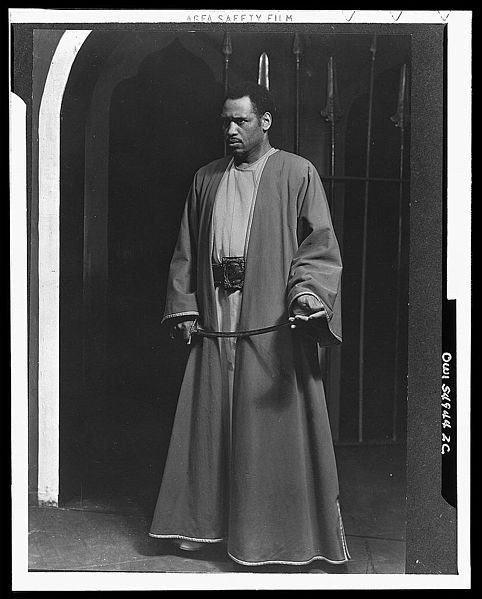How Did Shakespeare Think About the Issue of Race?
By Tom Porter
But what do The Bard’s plays tell us about the issue of race? It’s a question of particular interest to Associate Professor of English Aaron Kitch.
“Perhaps the most important thing to remember,” he said, “is that race means something quite different today, compared to what it did in Shakespeare’s time. It wasn’t until the nineteenth century.” he explained, “that race meant inherited, biological dispositions of features. At the turn of the sixteenth century race could mean a group with common ancestry, but it could mean a whole range of other things too.” Kitch teaches a class on this issue, and he also delivered the lecture Shakespeare’s Racial Imagination October 20, 2016, as part of the Bowdoin Book Lecture Series organized by the Association of Bowdoin Friends.

Historical context
At the time Shakespeare was writing—the late 1500s and early 1600s—England was not yet a major global player, said Kitch, but the expanding series of trade routes being established by merchant-adventurers like Sir John Hawkins, were laying the foundation for what would be the world’s biggest empire 150 years later. “The main empires in Shakespeare’s day were the Dutch, the Spanish, the Venetians and the Ottoman Turks. If you saw a person of color in London four hundred years ago,” said Kitch, “he was more likely to be a slave-owner than a slave.”
So while there was not established racism in the modern sense, there was a suspicion of darker skinned people—Moors from North Africa (“blackamoors” as they were often termed)—and indeed Queen Elizabeth I issued a proclamation that they be expelled. This hostility though, said Kitch, was more due to religious and political concerns than racial ones: Moors were likely to be closely associated with the Spanish empire, with whom England was at war for much of the time Shakespeare was writing.
And then there’s the issue of the slave trade, in which England participated. Sir John Hawkins was active in transporting captured slaves from West Africa to the Americas. Queen Elizabeth’s attitude towards this was conflicted, said Kitch. “On the one hand she opposed the practice of taking slaves against their will, but on the other hand she invested in Hawkins’ enterprises.”

Shakespeare’s characters of color
This complicated attitude towards race was reflected, for example, in Othello, explained Kitch, the character and the play. “One of the ironies of Othello is that the main character is black, but he’s also a general defending Christianity against the Turks.” Although he’s essentially a sympathetic character, said Kitch, Othello’s skin color does become an issue through the machinations of Iago, who is Othello’s ensign but hates his boss for promoting someone else ahead of him. As Iago’s plotting turns people against Othello, the latter’s color, and a fear of miscegenation fueled by Iago and his allies, causes Othello to take on racist attributes, including irrational behavior and uncontrollable rage.
Shylock, the Jewish money-lender from the Merchant of Venice, is another character whose racial identity becomes a central theme of the play, “although in this case,” said Kitch, “it’s more open to interpretation whether he’s an evil character, or just a victim of anti-semitism.” Shylock’s loan is relied upon in the play to enable one of the main characters, Bassanio, to pursue his love interest, Portia, and attain her hand in marriage. “Although Shylock is an alien within the state,” said Kitch, “the state is dependent on people like him to supply wealth and facilitate trade, so as well as race, the play is also about commerce and sexuality, because he’s the obstacle to all the marriages in the play.”
Another play Kitch talked about was The Tempest, which tackles issues of race and colonization, and which is thought to have been inspired by a real shipwreck in Bermuda in the early 1600s. Most of the main characters are Italian nobility who find themselves stranded on a remote island. Caliban, an island native, is described as villainous and deformed. He is always cursing his master, Prospero, who says of him “This thing of darkness / I acknowledge mine.” This idea of native people being enslaved by outsiders, said Kitch, “anticipates colonial discourse, even though England was more than a century away from having any empire to speak of.”

Shakespeare’s own thoughts on race?
Kitch said it’s crucial to remember that William Shakespeare never communicated directly to his audience about race or any other issue: he spoke through his characters, who of course represent multiple voices. “We don’t know if any of these voices are that of Shakespeare, but what’s interesting is the way he wants to stage problems and questions using the materials he finds. Whether it concerns a fantastical story, a shipwreck, court intrigue, navigation, politics, or anything else, he combines these elements and doesn’t say just one thing about race.”
Consider also, said Kitch, how Shakespeare’s ability to convey such a nuanced approach to the issue of race was helped by his extraordinary knowledge of the English language. “He had a vocabulary of about twenty-five thousand words, which is approximately ten times greater than the average English speaker in America.”
Listen to Aaron Kitch being interviewed on WBOR Radio (audio may take a few seconds to load)



